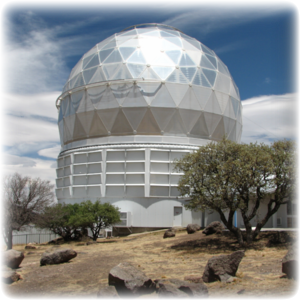Stellar astrophysics
 VARIABLE AND PECULIAR STARS AT LATER STAGES OF EVOLUTION
VARIABLE AND PECULIAR STARS AT LATER STAGES OF EVOLUTION
Studies of peculiar binary systems in the widest range of orbital periods, from decades to tens of minutes. Of particular interest is the further analysis of eclipsing systems, among wide pairs of stars such as Eps Aur / EE Cep objects and VV Cep / Dzeta Aur type stars, as well as close binary systems such as novae. The presence of dark dust disks and gas rings in wide pairs and accretion disks in close binaries makes them actually three component objects, both from spectroscopic and photometric point of view. A special place is occupied by symbiotic stars, especially those possessing a magnetized white dwarf (propellers). The main objective of the research is to distinguish between orbital effects (eclipses, periastron passages, proximity effects and scattering) and non-orbital effects (thermonuclear outbursts, high and low states of accretion activity, disk structure, etc.).
 POLARIMETRY OF OPTICAL PULSARS
POLARIMETRY OF OPTICAL PULSARS
The primary goal of our project is to understand the nature of neutron stars, which are the end products of the stellar evolution. Neutron stars are the objects with mass of about 1.5 Solar masses, while their diameter is only 20 kilometres. Besides, these stars have powerful magnetic fields and they rotate very fast, in extreme cases even with a rotation period of a few milliseconds. Therefore, neutron stars are unique laboratories to study relativistic effects. In our study, we focus on the optical polarimetric properties of the radiation of particular type of neutron stars, i.e. pulsars.
Pulsars are mainly discovered in the radio band of the electromagnetic spectrum using radio telescopes. Some of them are also observed in other spectral ranges: optical, X-ray or gamma. In the case of the optical range, the biggest problem with pulsar detection is their very low brightness which makes the detection difficult. Currently, only a few optical pulsars are known and only for one, i.e. the Crab pulsar, the optical polarization details are known. Our main goal is to measure the polarization of two other optical pulsars, Geminga and B0656+14. We are going to achieve our goals by using the POLISH2 optical polarimeter, that is going to be mounted on the 8-m Gemini North telescope on Hawaii, as well as on the 3-m telescope at the Lick Observatory in California. Also, we will also investigate the properties of polarized radiation of binary system which includes a millisecond pulsar and a low-mass stellar companion. Our research will help to understand the physical processes responsible for the emission of these exotic objects.
 PLANETARY NEBULAE
PLANETARY NEBULAE
Planetary nebulae have been fascinating astronomers and sky enthusiasts with their beauty for centuries. These objects are relatively rare in the Galaxy. They are related to the final stages of the stellar evolution, and not, as the name suggests, to planetary systems. The misleading name was given by William Herschel due to their resemblance to Uranus in his telescope. The relatively small number of observed nebulae may suggest that they are rare and extraordinary phenomenon. However, in fact most of the stars in the Galaxy presumably go through this stage of evolution. Planetary nebula will likely form from the envelope ejected by Sun at the end of its existence. The studies carried out at NCU’s Institute of Astronomy are recently focused on three-dimensional reconstruction of the planetary nebulae structures and on understanding of their formation.
 PTPS – SPECTROSCOPY
PTPS – SPECTROSCOPY
For a precise characterization of exoplanets detected within PTPS an extensive set of parameters describing the host stars is required. Therefore, spectroscopic analysis of all PTPS targets is being carried out in parallel to the planet search.
The group involves: A. Niedzielski, A. Wolszczan, M. Adamów, K. Kowalik, G. Maciejewski, B. Deka-Szymankiewicz

 Piwnice k. Torunia, 87-148 Łysomice
Piwnice k. Torunia, 87-148 Łysomice